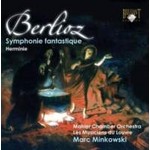
Symphonie fantastique, Op. 14 / Herminie - Scène lyrique (cantata)
 $20.00
Out of Stock
$20.00
Out of Stock6+ weeks add to cart
BERLIOZ
Symphonie fantastique, Op. 14 / Herminie - Scène lyrique (cantata)
Aurelia Legay (soprano) / Les Musiciens du Louvre & Mahler Chamber Orchestra, Marc Minkowski
[ Brilliant Classics / CD ]
Release Date: Thursday 20 August 2009
This item is currently out of stock. It may take 6 or more weeks to obtain from when you place your order as this is a specialist product.
Berlioz's Symphonie fantastique of 1830 was his direct response to hearing Beethoven's Ninth Symphony for the first time.
He claimed that the work 'took up music from where Beethoven left it'. There can be no doubt that the revolutionary German composer had a huge influence upon the hot-headed young French composer, who already had a thorough knowledge of Beethoven's Third, Fifth and Seventh Symphonies from a series of concerts given in Paris conducted by François Antoine Habeneck in 1828. However, Berlioz's style owes a lot to Cherubini and Spontini as well. These two giants of the Paris Opera were admired by Beethoven, Brahms and Wagner, and the 'modern' music they composed captured the feverish and impassioned imagination of the young Berlioz.
At the time of composing the Symphonie fantastique, Berlioz was head over heels in love with the Irish actress Harriet Smithson, having seen her in every production of Shakespeare. Berlioz placed himself, the artist, at the centre of the action in his programmatic symphony. Although the five movements or character pieces can be difficult to grasp if one approaches this work as one would a Beethoven symphony, once the events in the composer's life can be laid over the musical goings-on, the work suddenly gels into a fantastical journey through the mind of a love-obsessed, opium-drugged artist. Strange visions haunt him on his journey, and all these are illustrated in extraordinary scoring and effects. The early cantata Herminie (1828) was written for the Prix de Rome contest, and is one of four that Berlioz composed for the competition. He came second, probably due to the 'dissident' way he concluded the work, not in a blaze of glory which the conservative judges (led by Berton, who disliked Spontini intensely) expected, but in a quiet, lengthy diminuendo ending pianissimo for cellos alone. Otherwise the work is efficient and well executed. Berlioz drew on this work when composing his symphony Romeo and Juliet, and one theme from it appears in the Symphonie fantastique.
Tracks:
Symphonie fantastique, Op. 14
Herminie - Scène lyrique (cantata)
![Beatrice et Benedict (Complete opera) [Recorded in 1981] cover](https://images.marbecks.co.nz/_thumbnails/10152/10152550.jpg)